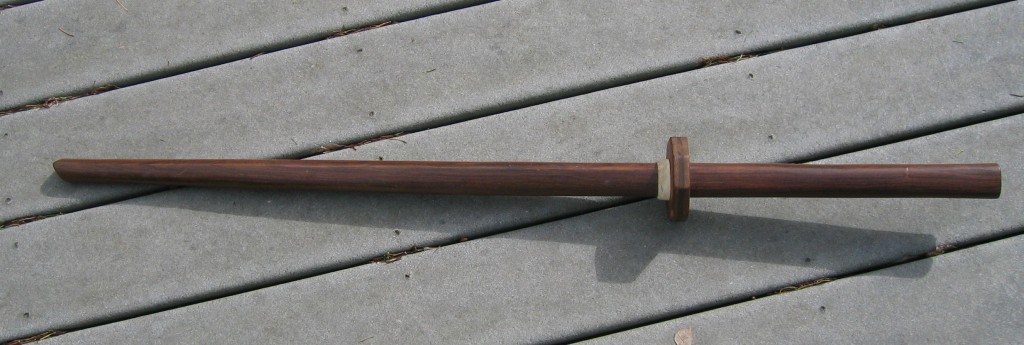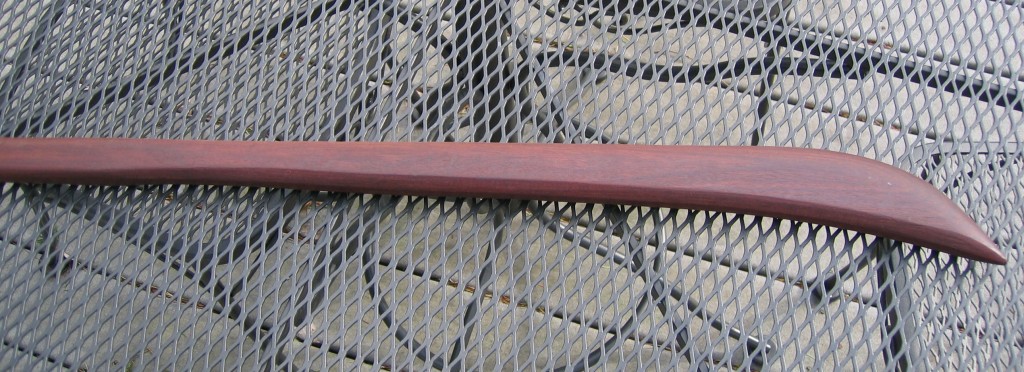This site focuses on wood used for practice weapons for martial arts. My main focus is classical Japanese martial arts, but informed practitioners of other martial traditions or combative training systems can certainly apply the information here to their own needs.
I would be very interested in any experiences you, the reader, have had with various woods. Given solid information, I will add woods to the list, or move their position to another category. I will note it, if I’ve actually used a wood for a weapon, or have a good report of same. Other woods are included because they show good potential, or I believe users would benefit from knowing about their limitations. Please contact me if you have any solid information to add to this list.
If you truly wish a general education on this subject, I recommend Samuel J. Records, The Mechanical Properties of Wood.
My criteria for a suitable weapon’s wood is based on general requirements necessary for use in Japanese weapons practice: of course, many of these criteria are equally valid for martial arts training in other cultures. Wood must be suitable for:
- Very hard impact
- A wood with some, but not too much flexibility
- A particular feel – the weapon has to feel alive in one’s hands
- Shock absorption
- Sufficient weight
A general caution:Tropical hardwoods grow in warm climates that are usually consistently moist, or consistently dry. Many don’t belong in colder climates, and particularly in woods not used to seasonal changes, they may expand and contract with the weather. This gradually weakens the wood. You will still have a very hard wood, unlikely to dent, but they may suddenly shatter with hard impact.
The Janka Hardness Scale is only one index of wood strength. The test measures the force required to push a steel ball with a diameter of 11.28 millimeters (0.444 inches) into the wood to a depth of half the ball’s diameter. The diameter was chosen to produce a circle with an area of 100 square millimeters. As you will see, there are quite a few woods that are utterly unsuitable for weaponry that are among the hardest, based on the Janka Scale. I’ve also seen different numbers for the same wood, which shows the variability of this living substance.
Other important factors are:
- Elasticity – reversible deformation – (how stiff the wood is)
- Bending Strength – (modulus of rupture)
- Resistance to sheering forces – (parallel to grain)
- Compression – (parallel to grain)
- Tendency to dry out: grain splitting, wood checking, and other flaws
- Tendency to splinter with impact, particularly “feathering”
- Dent resistance – (impact strength)
- Toughness – “A quality of wood which permits the material to absorb a relatively large amount of energy, to withstand repeated shocks, and to undergo considerable deformation before breaking”
- Work to Maximum Load – “In bending, it represents the ability of wood (or other materials) to absorb shock with some permanent deformation and more or less injury to the piece. It is a measure of the combined strength and toughness of wood under bending stresses.”
- Water content and proper cut of the grain can determine the quality of a piece of wood, far beyond Janka Index. You can have a marvelously variety of wood that, improperly cured or cut, will break at first impact.
The Wood Database has a great article on wood strength.
I’ve included various numerical values for some of the woods, which would seem to give a pretty reliable index of strength. In fact, the numbers are only generally useful. There are so many parameters that can only be “measured” by the impact of one weapon against another in dynamic rather than static tests. It is quite likely that some woods will seem quite strong when, for example, held in a frame and another weapon hit against it – however, with two moving bodies both exerting force, always at different angles, some of those woods will be useless. In this case, anecdote may be truer than “science.”
One can diminish the tendency of some woods to dent by “burnishing” (also known as “peening” or “boning”), in which one rubs the surface of the wood with a hard object (not too hard an object – bone, in fact, would be perfect). This slightly crushes the wood cells, packing them tighter together. This will work with some woods (purpleheart, for example) and not others (ipe). You will need to experiment to ascertain if it is helpful with the wood you are using.
Tim Bathurst of the Melbourne Koryu Kenkyukai writes
When purchasing wood for weapons, carefully examine the wood. Depending on how the wood was farmed/grown, the differences in density can be significant. Species that have an average hardness rating of ‘very hard’ (over 10 on the Janka scale, appear 2000 in the English system) can often be noticeably softer if they were farmed in hotter climes. I’m not advocating logging old growth forests however; trees grown on farms with regular water, in warmer climates allow the trees to grow faster with less densely compacted growth rings. There can be a great difference in density depending on how quickly the tree grew. Especially with trees that tend to have a ‘wild grain,’ such as Gum trees, be careful to flip the timber and ensure that the grain runs consistently down the length and parallel through the whole piece, otherwise it will be prone to snap.
Another vital consideration is grain pattern. You really want the grain to run right through the weapon. If the grain runs vertically through the weapon, this will give it maximum strength. If the grain runs across the weapon, especially in the case of a naginata, it will mean that the tip will have a much greater chance of snapping off.
Important: Don’t believe the numbers only
When I decided to make my own weapons I naturally went to the internet to research which species would be the most appropriate for my impact weapons such as naginata and bokken. According to many of the charts on wood density, many of the species commonly known as “gum trees” (Eucalyptus) are rated very high on the Janka rating system. This is a standard test which measures the penetration into the timber of a common load and projectile. The results relate to a hardness capacity of the material and are expressed in kN. This information is useful where the timber may be subject to potential damage from impacts e.g. a dance floor or martial arts weapons. Upon inspection, it became obvious that the charts are more of a general rule, because there were a lot of examples of woods that look good on paper but performed less impressively when struck, either denting or splintering.
Finishing the job
Over the years I have tried many different oils and waxes to polish and preserve my wooden weapons. If you have the time and equipment you can burnish your weapons by coating them in burnishing oil or Tung oil then sand them with a fine “wet and dry sandpaper” of 600 grade or higher. After several coats you can rub the weapon with a very fine steel wool (grade “00”) Eventually this will create a glass like finish to your wooden weapons. If you have limited time here’s an alternative… I use a car “cut and polish compound.” Simply wipe it on with a sponge and then wipe it off with a clean cloth and the wood comes up shiny and smooth without the grippy, waxiness you can get from using oils. I originally saw a guy ‘polishing’ a coffee table this way, I was skeptical at first but the results were amazing.

